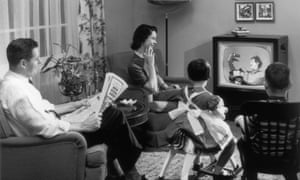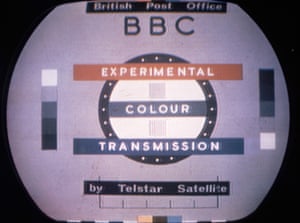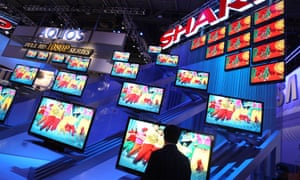Having gone from humble black-and-white beginnings, 2016 will see TV set free from the television set to be consumed wherever and whenever you want

Since its first demonstration in the mid-1920s television has gone through five major shifts that affect the way viewers consume it. Now we’re on the verge of a sixth shift that will bring it kicking and screaming into a brave new world of TV everywhere.
The UK is the most advanced TV-watching country in the world, according to Ofcom, and has seen a record rise in the use of tablets for consuming media. The living room TV is no-longer the be-all and end-all of television consumption.
The change is being driven by the younger generations. Recent data from Childwise suggests children aged under five are watching more TV than ever at 2.6 hours a day, accessing on-demand content through tablets and other devices. Meanwhile, Childwise also found that, on average, five- to 15-year-olds are spending more time online than sat in front of the TV.
They are place-shifting their content, watching TV online through devices at a time that suits them. This year will see that behaviour cemented with the continued rise of on-demand and the launch of new services, such as Sky Q, which allow all television to be place-shifted – the sixth evolution of TV.
Black and white

The first televisions were black and white. Pictures were initially grainy but steadily got better as the camera or scanning systems improved. Amplified mechanical televisions such as that invented and demonstrated by John Logie Baird in 1925 peaked at 240-lines in 1936. Each line scanned across the television to create an image.
Electric televisions, which are more akin to what is in use today, were first demonstrated to the public in 1932 by American inventor Philo Farnsworth. TheBBC broadcast the first regular “high-definition” television service from Alexandra Palace on 2 November 1936 with 405-lines of black and white pictures. By contrast most of today’s TVs have the equivalent of 1,080 lines.
Colour

Black and white television continued to improve, but it wasn’t until 1954 that the first colour broadcasts were introduced in the US. The system used a new National Television Systems Committee (NTSC) standard encoding brightness and colour separately so that black and white TVs could use the signal too.
A European colour standard wasn’t set until 1963 with Phase Alternating Line (PAL), which was technically superior and able to deal with weather better than NTSC. Colour broadcasts did not start in Europe until 1967 with BBC2 becoming the first channel in the UK to broadcast in colour, spearheaded by then-controller Sir David Attenborough.
Colour television continued to improve in quality, with screens becoming larger and sharper, cameras more sensitive, and broadcasts stronger for better picture quality.
Time-shifting

The next big change in TV technology came in the form of time-shifting, although the word “time-shift” hadn’t been invented yet.
Video tape recorders were developed in the early 1950s using reel-to-reel magnetic tape and were employed by the television industry. An evolution of that technology made it into homes as the video cassette recorder in various formats by the 1970s, starting with the Philips Model 1500 in 1972.
It was the first time that users could record a programme and then play it back at a time convenient to them, the very basis of time-shifting, leading to one unsuccessful entrant even being called “the great time machine”.
VHS recorders won the battle for the time-shifting tape format, which were succeeded by DVD recorders and hard-drive based digital video recorders (DVR) starting in 1999. DVD recorders died out but DVRs continue to be popular, forming the basis of most time-shifting equipment and broadcast TV recorders that can “pause live TV”.
Digital TV

After the invention of time-shifting, digital television broadcasting was the biggest thing to happen to TV since colour – and, combined with DVRs, it paved the way for further evolution.
Digital television brought with it many advantages over analogue TV. The most obvious for the consumer was an increased picture quality and an expansion of the number of channels that could be broadcast at the same time over the same radio frequencies. Digital TV also enabled enhanced services, typically accessed through the “red button” and a replacement of the teletext services.
Several specifications battled it out for the digital TV crown in the 80s and 90s, with various countries and regions adopting different standards, but it wasn’t until 1998 that the first digital broadcast was made in the UK.
The digital switchover followed in most countries, where the analogue broadcasts were switched off leaving only the digital broadcasts, which paved the way for new 4G mobile data services in the UK by releasing the existing spectrum for new uses.
The airwaves that carried fuzzy analogue TV now carry your cat gifs, breaking news and place-shifted video, but more on that later.
Widescreen and HD

Around the same time as digital television grew in popularity, the 16:9 widescreen format started to replace the original squarer 4:3 format. The widescreen format allowed wider framing of TV shots, as well as being a better fit for films on TV without the use of large black bars at the top and bottom of the picture, called letterboxing or cropping the video.
Widescreen broadcasts started in the UK in 1998 along with digital television. A few widescreen televisions were available before the introduction of digital TV in the UK, but in the early 2000s they grew in number and popularity eventually pushed out 4:3 TVs.
Between 2000 and 2003, most TV broadcasters in the UK switched to 16:9 before introducing HD channels, starting with BBC HD and Sky’s HD channels in 2006 via satellite. Channel 4, ITV, Channel 5 and most others followed suit, producing HDTV channels, while terrestrial HD broadcasting was introduced in 2009 with Freeview HD.
HD TV, 1080i television broadcasts have five times the number of pixels as standard definition, which produces a much crisper, sharper picture and has allowed screens to grow in size without looking pixelated or blurry at normal viewing distances.
The UK lagged well behind the US in the adoption of HDTV, which first started broadcasting in HD in 1996 before official adoption in 1998. Europe’s first HDTV broadcast to the home was in 2004 in Belgium.
Ultra-high definition (UHD), also known as 4K, due to its 3840 x 2160 pixel resolution, meaning it is almost 2,000 by 4,000 lines in old screen terminology, is thought to be the logical successor to 1080i HD broadcasts. It’s too early to see if that is true, but as 3D TV, which has been and gone, has shown, not everything succeeds.
Place shifting

At least 10 years of HD broadcasting later, we’re now on the verge of a mass adoption of the next evolution of television: place-shifting.
It all started with devices such as the Slingbox in 2005, which allowed users to watch TV streamed from their homes anywhere they have an internet connection. That “anywhere at any time” model was later adopted by services such as Netflix and the BBC iPlayer. The ability to watch what you want, when you want and wherever you want (within the UK) where you have an internet connection has proven popular.
Now even traditional broadcasters are starting to enable users to place shift. Sky’snew Q system, for instance, allows users to stream broadcast television around the home using a home network as well as download shows onto a tablet or stream them via an app. That’s in addition to Sky’s Go streaming and video on-demand services.
BBC’s iPlayer, ITV Hub, All4, as well as Virgin’s TV anywhere and others also do a similar job in a less sophisticated fashion, that means almost anyone can now place-shift their content and consume it on their own terms.
Like time-shifting before it, place-shifting is an important evolution of the television experience and crucial for it to stay relevant in the on-demand era, when competing with so many other instant forms of entertainment.
The biggest thing standing in the way of every service allowing place shifting is copyright protection and the regional licence agreements with movie and television studios.
Streaming service Netflix, for instance, has recently been forced to crack down on the use of region unblockers – tools that allow a UK customer to access content from the US library, bypassing restrictions – demonstrating the power of regional restrictions.
On home turf, Sky Q and its rivals will likely bring place-shifting to the mass market, beyond the tech savvy, which makes 2016 look like the year of TV anywhere.















